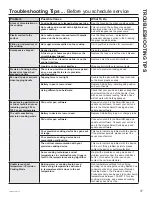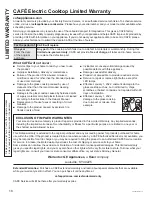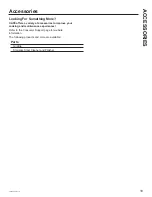
4
49-2001129 Rev. 2
SAFETY
INFORMA
T
ION
READ AND SAVE THESE INSTRUCTIONS
IMPORTANT SAFETY INFORMATION
READ ALL INSTRUCTIONS BEFORE USING THE APPLIANCE
How to Remove Protective Shipping Film and Packaging Tape
Carefully grasp a corner of the protective shipping film
with your fingers and slowly peel it from the appliance
VXUIDFH'RQRWXVHDQ\VKDUSLWHPVWRUHPRYHWKHILOP
Remove all of the film before using the appliance for the
first time.
To assure no damage is done to the finish of the
product, the safest way to remove the adhesive from
packaging tape on new appliances is an application of
a household liquid dishwashing detergent. Apply with a
soft cloth and allow to soak.
NOTE:
The adhesive must be removed from all parts. It
cannot be removed if it is baked on.
Consider recycling options for your appliance packaging
material.
WARNING
COOKTOP SAFETY INSTRUCTIONS
Ŷ ,QWKHHYHQWRIDILUHGRQRWXVHZDWHURUJUHDVHRQ
ILUHV1HYHUSLFNXSDIODPLQJSDQ7XUQWKHFRQWUROV
off. Smother a flaming pan on a surface unit by
covering the pan completely with a well-fitted lid,
FRRNLHVKHHWRUIODWWUD\8VHDPXOWLSXUSRVHGU\
chemical or a foam-type fire extinguisher.
Ŷ 1HYHUOHDYHWKHVXUIDFHXQLWVXQDWWHQGHGDWPHGLXP
or high heat settings. Boilovers cause smoking and
greasy spillovers that may catch on fire.
Ŷ 1HYHUOHDYHRLOXQDWWHQGHGZKLOHIU\LQJ,IDOORZHG
to heat beyond its smoking point, oil may ignite
resulting in fire that may spread to surrounding
FDELQHWV8VHDGHHSIDWWKHUPRPHWHUZKHQHYHU
possible to monitor oil temperature.
Ŷ 7RDYRLGVSLOORYHUDQGILUHXVHDPLQLPXPDPRXQW
of oil when shallow pan-frying and avoid cooking
frozen foods with excessive amounts of ice.
Ŷ 8VHWKHSURSHUSDQVL]HVHOHFWFRRNZDUHKDYLQJ
flat bottoms large enough to cover the surface
heating element. The use of undersized cookware
will expose a portion of the surface unit to direct
contact and may result in ignition of clothing. Proper
relationship of cookware to surface unit will also
improve efficiency.
Ŷ 7RPLQLPL]HWKHSRVVLELOLW\RIEXUQVLJQLWLRQRI
flammable materials and spillage, the handle of a
container should be turned toward the center of the
range without extending over nearby surface units.
WARNING
RADIANT COOKTOP SAFETY INSTRUCTIONS
Ŷ 2QO\FHUWDLQW\SHVRIJODVVJODVVFHUDPLF
earthenware or other glazed containers are suitable
for cooktop service; others may break because of
the sudden change in temperature.
Ŷ 8VHFDUHZKHQWRXFKLQJWKHFRRNWRS7KHJODVV
surface of the cooktop will retain heat after the
controls have been turned off.
Ŷ 'RQRWFRRNRQDEURNHQFRRNWRS,IWKHJODVV
cooktop should break, cleaning solutions and
spillovers may penetrate the broken cooktop and
create a risk of electric shock. Contact a qualified
technician immediately.
Ŷ $YRLGVFUDWFKLQJWKHJODVVFRRNWRS7KHFRRNWRS
can be scratched with items such as knives,
sharp instruments, rings or other jewelry, and
rivets on clothing.
Ŷ 'RQRWSODFHRUVWRUHLWHPVWKDWFDQPHOWRUFDWFK
fire on the glass cooktop, even when it is not being
used. If the cooktop is inadvertently turned on, they
may ignite. Heat from the cooktop or oven vent after
it is turned off may cause them to ignite also.
Ŷ 8VHDFHUDPLFFRRNWRSFOHDQHUDQGDQRQVFUDWFK
cleaning pad to clean the cooktop. Wait until the
cooktop cools and the indicator light goes out
before cleaning. A wet sponge or cloth on a hot
surface can cause steam burns. Some cleaners can
produce noxious fumes if applied to a hot surface.
Read and follow all instructions and warnings on the
cleaning cream label.
NOTE:
Sugary spills are an
exception. They should be scraped off while still hot
using an oven mitt and a scraper. See the Cleaning
the glass cooktop section for detailed instructions.
PROPER DISPOSAL OF YOUR APPLIANCE
'LVSRVHRIRUUHF\FOH\RXUDSSOLDQFHLQDFFRUGDQFHZLWK)HGHUDODQG/RFDO5HJXODWLRQV&RQWDFW\RXUORFDO
authorities for the environmentally safe disposal or recycling of your appliance.





































